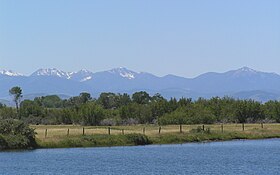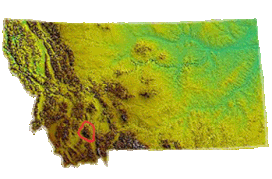Tobacco Root Mountains
| Tobacco Root Mountains | |
|---|---|

Panoramic view of Tobacco Roots
|
|
| Highest point | |
| Peak | Hollowtop Peak |
| Elevation | 10,604 ft (3,232 m) |
| Geography | |
| Country | United States |
| State | Montana |
| Range coordinates | 45°33.3′N 111°58.5′W / 45.5550°N 111.9750°WCoordinates: 45°33.3′N 111°58.5′W / 45.5550°N 111.9750°W |
| Parent range | Rocky Mountains |
The Tobacco Root Mountains lie in the northern Rocky Mountains, between the Jefferson and Madison Rivers in southwest Montana. The highest peak is Hollowtop at 10,604 feet (3,232 m). The range contains 43 peaks rising to elevations greater than 10,000 feet (3048 m).
Much of the central part of the range is within the Beaverhead-Deerlodge National Forest, although many, mostly small patented mining claims exist within the forest boundary. The range saw significant gold mining, especially during the 1880s to 1930s.
The high peaks have been extensively glaciated, and most of the larger stream valleys held valley glaciers during the ice age.
When Lewis and Clark came through southwest Montana in 1805, they named many rivers — but if they referred to the mountain ranges by name, the names are not recorded. The 1865 DeLacey Map of Montana Territory does not name the Tobacco Roots. The first written reference to the mountains between the Madison and Jefferson Rivers is F.V. Hayden’s 6th Annual Report of the Geological Surveys of the Territories for 1873, in which the name South Bowlder Range is mentioned, a reference to the largest river in the north part of the mountains. Although this usage (usually spelled “South Boulder Range”) is followed in many Geographies and Atlases of the 1890s and early 1900s, the USGS Three Forks Folio labels the mountains “Jefferson Range.”
The earliest known use in print of the name Tobacco Root Mountains is Winchell’s (1914) report on mining districts of the Dillon Quad. The name was also used by Billingsley in a 1918 paper on the Boulder Batholith, published by the American Institute of Mining Engineers. “Tobacco Root” appears in most subsequent publications, including Montana Bureau of Mines and Geology reports (at least since 1933), National Forest Maps (since 1938), and the Official Montana Highway Maps.
However, a map in Fenneman’s Physiography of Western United States (1931) shows a long Jefferson Range to include what is now called the Tobacco Roots plus the Gravelly Range. Oil Company highway maps from the late 1960s and early 1970s show “Tobacco Root Mountains” in the north, and “Jefferson Range” in the south (northwest of Ennis and north of Virginia City). Preliminary topographic maps of the area (Bureau of Reclamation, Missouri Basin Project) from 1947-48 show Jefferson Range, but on the 1950 15-minute sheet (Harrison Quad) the identical topography is labeled “Tobacco Root Mountains” in the same place as “Jefferson Range” on the maps that were just two years older.
...
Wikipedia

